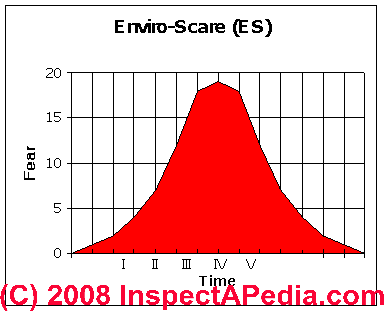 Environmental Hazards, Consumer Fear, & Property Values
Environmental Hazards, Consumer Fear, & Property Values
Enviro-Scare:
The Normal Curve Cycle of Public Fear of Environmental Issues and its Effect on Property Values
- POST a QUESTION or COMMENT about the cycle of pubic anxiety surrounding potential or actual environmental hazards
Enviro-Scare topics defined & illustrated by examples: asbestos, EMF, Lead, Radon.
This article series defines enviro-scare: public or individual fear of actual-important environmental hazards as well as imagined environmental hazards. It is often easy to become confused about the difference between real and immediate hazards versus more theoretical hazards or worse, imagined hazards to public health.
Significant costs and economic losses due to Enviro-Scare include both failure to respond properly to a real hazard and inappropriate and costly responses to hazards that are either not real or are exaggerated.
Here we discuss a range of common environmental topics around which cycles of public fear rise and fall, sometimes independent of the actual health hazard involved, and sometimes, even where real hazards are involved fear produces an industry that can lead to unjustified economic losses.
InspectAPedia tolerates no conflicts of interest. We have no relationship with advertisers, products, or services discussed at this website.
- Daniel Friedman, Publisher/Editor/Author - See WHO ARE WE?
What is "Enviro-Scare" and What Public Fear About Environmental Hazards Mean to Building Owners
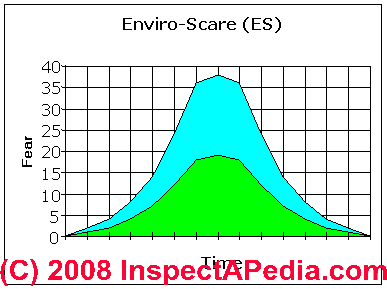
[Click to enlarge any image]
Article Contents
- ENVIRO-SCARE - PUBLIC FEAR CYCLES
- DEFINITION of ENVIRO-SCARE
- PHASES of PUBLIC FEAR LEVEL vs TIME - worry rises, peaks, falls predicatably
- ASBESTOS ENVIRO-SCARE - real & less likely asbestos hazards in buildings
- CHINESE DRYWALL ENVRIO-SCARE - outgassing from Chinese-made drywall caused building damage
- EMF or EMF ENVIRO-SCARE - Electromagnetic Fields (EMF) or Electromagnetic Radiation (EMR)
- FIBERGLASS INSULATION ENVIRO-SCARE- large vs. small particle hazards are confounded
- LAMINATE FLOORING FORMALDEHYDE OUTGASSING - public concern raised over possible formaldehyde released from Chinese-produced laminate flooring sold in the U.S. by Lumber Liquidators
- LEAD PAINT ENVIRO-SCARE - Lead hazards in building dust, in building Paint or Water Supply Piping
- MOLD ENVIRO-SCARE - public fear and marketing conflate real hazards with imagined ones
- RADON ENVIRO-SCARE - Radon gas hazards in buildings
- UFFI ENVIRO-SCARE - Urea Formaldehyde Foam Insulation - UFFI and Cancer
Additional Enviro-Scare topics such as public worry & actual hazards concerning Bisphenol, BPA, vinyl chloride & PVC, and dust from the World Trade Center WTC collapse are found at CONTINUE READING .
Also
see FEAR-O-METER: Dan's 3 D's SET REPAIR PRIORITIES - how to translate levels of concern about building damage or hazard observations into action levels
Definition of Enviro-Scare Cycles
We coined the term "Enviro-Scare" in the 1980's to describe the cyclic growth then decline of consumer fear about various environmental issues. As I indicated at the introduction, the graph depicts the varying level of public fear or "Enviro-Scare" for a given environmental concern. This pattern also occurs for many other public anxieties.
"Enviro-scare" generally increases, peaks, and then diminishes over time. The level of fear in an enviro-scare curve is mapped on the chart's vertical axis, increasing from the chart bottom towards its top.
Time is mapped on the horizontal axis, increasing from left to right.
The phases of the enviro-scare cycle: increasing fear, peak fear, and declining fear map the curve's up-slope, peak, and declining slope. This behavior can be represented by a normal curve. At its right end the curve approaches zero (no fear) but never quite reaches it.
Examples of enviro-scare topics discussed in this article series include asbestos in buildings, EMF or electromagnetic fields, fiberglass insulation fragments, lead paint, mold contamination, radon gas, UFFI or urea formaldehyde insulation, electromagnetic radiation or electromagnetic fields (EMF) as a possible cancer risk and offers a brief analysis of the probable cancer risk from EMF compared with other hazards. We also discuss
- The normal pattern of rise and fall of public fear for most environmental hazards, real or imagined
- The effect of environmental hazards and public fear on real estate prices?
- Common environmental or building hazard topics around which cycles of public fear or "environ-scare" are common?
Predictability of Public Fear vs Time for Most Environmental Concerns
The level of Enviro-Scare (ES), or consumer concern, moves in a predictable pattern: increasing fear, peak, then declining fear. What is significant is that the level of public fear follows this pattern based on mediate attention and a public perception of risk, rather than on the actual risk of a particular hazard.
Thus both genuinely dangerous conditions and those which are really insignificant both follow the ES cycle. This pattern of human response to frightening conditions has been documented in other fields, such as public fear of crime waves, and in another form, public enthusiasm for particular products - the Dutch Tulip Mania at the turn of the last century or the pet rock come to mind.
The two colors and two different curve slopes in the illustration shown at page top and below simply portray two different enviro-scare topics, one of which increases faster and reaches a higher level of concern than another.
Having worked with building owners and buyers for quite some time, we have personally observed the "enviro-scare" cycle across a variety of environmental hazards, some real and important and some at least eventually considered probably insignificant.
The statements below about the current level of enviro-scare on each topic discussed are simply the author's opinion based on contact with home owners, buyers, and Building inspectors in U.S. More scientific surveys could certainly be designed and conducted.
Who pays for building inspections and environmental tests?
When a building is being purchased, the responsibility for identifying (testing for) and planning to deal with asbestos materials in a building usually rests with the building buyer, as it should: the buyer needs to be absolutely sure that any inspections or tests on a building, including the home inspection, are done by a person with no conflicts of interest.
In some transactions the ultimate cost of tests may be negotiated between the buyer and seller, but if the buyer hires and pays for the inspector, all parties, seller, buyer, realtors, attorneys, are protected from a possible conflict of interest and fear of biased or careless inspecting and reporting.
Phases of Enviro-Scare and Effects on Real Estate & Property Values Due to Public Fear of Environmental Hazards
 If a building owner wants to sell the property, the impact of the presence of an environmental issue on the real
estate transaction depends on the time, or point in the fear cycle, at which the property is being marketed.
If a building owner wants to sell the property, the impact of the presence of an environmental issue on the real
estate transaction depends on the time, or point in the fear cycle, at which the property is being marketed.
The time until a property moves from phase I to phase II is extremely difficult to predict. However it may be easier to detect phase III, the beginning of decline in consumer fear.
[Click to enlarge any image]
Properties on the "up-slope" of the ES curve, phase II, face declining market value or increasing time on the market unless a price adjustment is made.
The opposite is true of properties on the "down-slope" or phases III and IV. This concept may be useful in advising home buyers and sellers concerning the economic impact of the presence of various controversial health or environmental issues at a given property.
It is worth noting that these changes in the level of public fear of environmental hazards over time occur regardless of whether the hazard is ultimately found to be real and dangerous or imagined and harmless.
It is also important to understand that while the level of public fear ultimately drops to a low level, it may never fall to zero.
Enviro-Scare about Asbestos in buildings: asbestos pipe insulation in buildings and asbestosis, & asbestos cement building siding
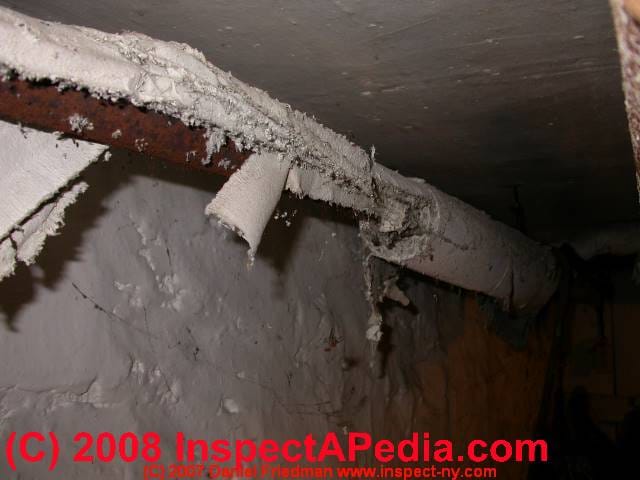 Here is a summary of the health risks and property value risks associated with exposure to asbestos in buildings.
Here is a summary of the health risks and property value risks associated with exposure to asbestos in buildings.
Asbestos, a natural mineral fiber mined from the ground includes very small fibers which, if inhaled, can form a possible cause of lung cancer, in particular mesothelioma.
Asbestos insulation on pipes or HVAC equipment
At left is a photograph of asbestos pipe insulation in poor condition.
[Click to enlarge any image]
This is an unsafe condition, presenting asbestos hazards at least to people entering this area and potentially to other building occupants if people (or even air) movement in and out of this area transports asbestos dust and debris to other building areas.
Most likely professional remediation - removal in this case - is appropriate.
Watch out: There is no doubt that exposure to high levels of airborne asbestos has been demonstrated to be a serious health hazard (John Mansville's class action lawsuit). At the peak of the asbestos enviro-scare, very costly asbestos abatement projects were performed. But below we also warn of the opposite hazard: becoming frightened about asbestos materials that are in good condition and can or even should be left alone.
After many cases of inadvertent cross-contamination of building areas by asbestos stirred-up during removal, a careful discipline for asbestos abatement was developed as well as training and licensing requirements.
Current "best-advice" for asbestos pipe insulation in buildings is to leave it alone unless it is in poor condition (falling off) or it is in a location subject to mechanical damage and release in an occupied area.
That's because it was discovered that the asbestos level in buildings was worse from it being disturbed than if it were left alone. The current level of public enviro-scare about asbestos has diminished significantly, but as with UFFI, not to zero.
See IDENTIFICATION of ASBESTOS in buildings for details about the visual identification of asbestos-containing materials in buildings.
Cement asbestos siding enviroscare?
Some consumers may also be worried about owning, re-selling, maintaining or remodeling a home whose exterior is clad with cement-asbestos shingles.
Cement asbestos shingles are a cementious material, not friable, and unlikely to release a measurable level of fibers into the air around a building unless the siding is being attacked with power tools such as saws, sanders, or during actual building demolition.
If, however, demolition of this material is planned, some communities may require special handling and special disposal, adding to the remodeling or demolition cost.
For this reason some owners simply install new siding atop the old, burying it in the building where it is not visible and where it will not be damaged by other building activities.
More advice about asbestos cement building siding as well as its repair or replacement with fiber cement shingles that do not contain asbestos can be read
Asbestos-containing Asphalt Flooring or Vinyl Flooring Enviro-Scare
Watch out: above we warned of very real asbestos hazards in conditions, particularly in industrial settings, where high levels of airborne asbestos exposure were or are likely.
But other asbestos-containing materials in buildings may be in good condition and should be left alone - as cited earlier for asbestos pipe insulation in good condition - it may merit encapsulation rather than removal.
See ASBESTOS FLOOR TILE IDENTIFICATION PHOTOS 1949-1959.
Leaving asbestos-containing vinyl or asphalt flooring in place is recommended for flooring that is in good condition and not in a public space such as a school or is not in a place where it is to be disturbed by building activities such as demolition or renovations.
At above left is an asphalt asbestos floor in poor condition: at least partial removal of this floor may be appropriate.
Be sure to use a licensed, trained asbestos contractor for such work as an amateur may make a dusty mess that actually increases the ultimate cost of asbestos cleanup.
See ASBESTOS REMOVAL GUIDE, FLOORING for dealling with an asbestos-containing floor that must be removed.
Above our photo shows an asbestos-floor tile installation in good condition. This floor can most likely be left in place. Several approaches are offered to reduce the hazard of asbestos-containing flooring or "presumed-asbestos-containing flooring" that is intact and can be left in place.
See ASBESTOS FLOORING HAZARD REDUCTION
and
See ASBESTOS FLOORING LEFT IN PLACE for dealing with an asbestos-containing floor that is in good shape and can be left in place.
Chinese Drywall Outgassing Envrio-Scare History
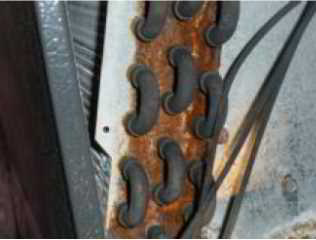 Chinese drywall s received considerable attention in the U.S. as a source of odors, health hazards, and even corrosion of HVAC equipment, electrical wiring, and piping, found in North American homes renovated or built since 2001, and especially in homes built in 2006 and 2007.
Chinese drywall s received considerable attention in the U.S. as a source of odors, health hazards, and even corrosion of HVAC equipment, electrical wiring, and piping, found in North American homes renovated or built since 2001, and especially in homes built in 2006 and 2007.
CPSC staff modeling based on these results shows that estimated concentrations of the reactive sulfur chemicals in the indoor air of a home that are predicted to result from the presence of the drywall can be approximately a factor of ten times greater for certain Chinese samples than for the non-Chinese samples. - cited
A result of H2S outgassing from this Chinese drywall was corrosion of reactive building components, particularly copper such as copper piping, electrical wiring, and thinner copper tubing used in air conditioning and heast pump systems.
In some parts of the United States these problems led to costly demolition and replacement projects to remove and replace both the problematic drywall and damaged building mechanical system components.
Early Chinese drywall complaints also rasied concerns about possible bacterial contamination in some Chinese drywall but ultimately it was demonstrated that the issues were with the smell of H2S not bacterial contaminants.
Details are at CHINESE DRYWALL HAZARDS
Enviro-Scare & Electromagnetic Field (EMF) or Electromagnetic Radiation (EMR)
Our page top illustration graphs the effect of fear of power lines and EMF exposure as well as other environmental concerns as it affects property values over time.
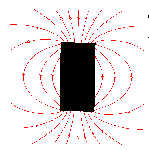 We define "Enviro-Scare" (ES) and we use
this cyclic fear pattern to describe the variation and effects of the level of public environmental worry by recapping
the enviro-scare history of asbestos, EMF, UFFI, and other environmental concerns.
The red graph depicts the varying level of ES or public fear for a given
environmental concern. ES generally increases, peaks, and then diminishes over time, independently of the actual level
of risk.
We define "Enviro-Scare" (ES) and we use
this cyclic fear pattern to describe the variation and effects of the level of public environmental worry by recapping
the enviro-scare history of asbestos, EMF, UFFI, and other environmental concerns.
The red graph depicts the varying level of ES or public fear for a given
environmental concern. ES generally increases, peaks, and then diminishes over time, independently of the actual level
of risk.
As people become acclimated to the particular topic it loses its initial shock value.
Every (electric) current going through a wire generates magnetic radiation which travels around the wire. There is continuing controversy regarding possible health effects of exposure to this radiation.
The U.S. Environmental Protection Agency (EPA) and the U.S. Navy performed a study which reported that 5 out of 6 laboratories found increased levels of embryological changes in chickens when exposed to magnetic radiation.
Other tests have shown biological effects on mice, miniature pigs, and humans. Recent articles claim or at least suspect that exposure to high levels of ELF radiation is a factor in leukemia in children. A recent article in The New Yorker Magazine along with other media reports have focused public attention on this topic.
Magnetic radiation surveys measure Extremely Low Frequency (ELF) and Very Low Frequency (VLF) fields which have nothing to do with high frequency radioactivity such as radon, X-rays, and so-called ionizing radiation. In a separate article we report on several recent studies and articles which discuss the health issues regarding ELF and VLF radiation.
Magnetic radiation is produced by high tension power lines, but also by ordinary secondary lines, power transformers, household wiring, certain electric radiant heating devices, improperly grounded appliances.
For details about electromagnetic field hazard assessment see the articles listed at page top or at the MORE READING links at the bottom of this article .
Enviro-Scare about Electromagnetic Field EMF Exposure and cancer
The current level of enviro-scare about EMF exposure is quite low
but not zero, as with asbestos and UFFI. We discuss this topic in depth
at ELECTROMAGNETIC FIELD MEASUREMENT PROCEDURES
For details about electromagnetic field hazard assessment see these articles:
- EMF Cancer Scare
- EMF RF FIELD & FREQUENCY DEFINITIONS
- EMERGENCY RESPONSE, IAQ, GAS, MOLD
- EMF ELECTROMAGNETIC FIELDS & HUMAN EXPOSURE
- Also see EMF RF FIELD & FREQUENCY DEFINITIONS
for a simple explanation of different types of radio frequency (RF) and electromagnetic frequency (EMF) types and where they are found.
Enviro-Scare about Formaldehyde Outgassing from Chinese Made Laminate Flooring
See FORMALDEHYDE in LAMINATE FLOORING - is there a hazard from formaldehyde outgassing from Chinese-made laminate flooring sold in the U.S. by Lumber Liquidators? Should we test flooring for formaldehyde outgassing, and if so, how should we test for formaldehyde gas exposure levels indoors; if high levels of formaldehyde are found, have we properly identified the source? What are the remedies for high levels of indoor formaldehyde gas?
Enviro-Scare about Lead in building Paint or Water Supply Piping and Neurological or other health risks
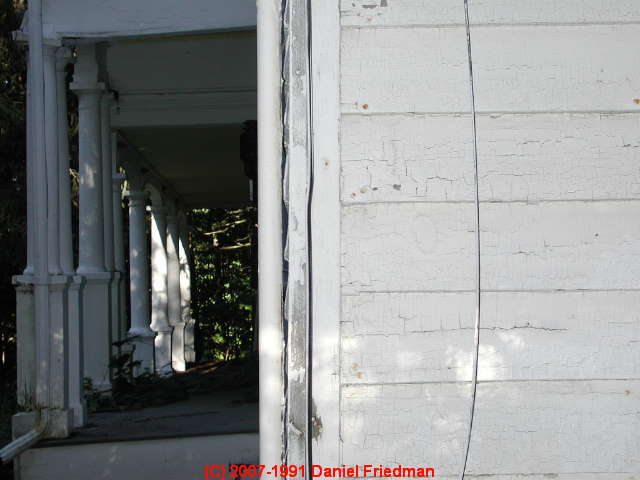 How Serious is the Environmental Hazard from Lead in Paint
How Serious is the Environmental Hazard from Lead in Paint
Lead in paint is likely to be a real risk in buildings, especially to children. The actual risk depends on the dose: the actual level of lead consumed.
Building conditions which increase the risk of lead paint ingestion include the location of surfaces where lead paint was used, the condition of the surface, activities which release lead-dust such as certain types of cleaning, sliding window sashes up and down, and building renovation work.
Lead was used as paint in buildings in the U.S. up to 1978, so unless a pre-1978 building has no painted surfaces it's reasonable to assume that lead paint is present.
Thus superficial testing for the "presence/absence" of lead paint is not a step I'd recommend, though for appropriate cases I do recommend a lead survey by a qualified expert.
Lead enviro-scare has generated an industry selling "lead tests" for paint, often based on rather unreliable chemical swabs.
A trained expert, using an x-ray inferometer, can sample the appropriate building surfaces at a property and will prepare a document describing the important risks and should prepare a lead abatement plan if action is needed. Some U.S. states such as Massachusetts require lead abatement in buildings at the time of property transfer.
Because any pre-1978 painted building is likely to have lead paint on some surfaces, homes for sale and with this enviro-scare hazard are not particularly stigmatized (from a property valuation concern for lead paint) since most homes of similar age have the same paint concerns.
The result is a flatter enviro-scare curve, with its right-hand tail leveling out higher above zero. The current level of enviro-scare about lead in paint is moderate and probably stable.
See LEAD TEST KIT for HOME USE for a simple test kit for lead on building surfaces, pottery (photo below), toys, etc.
How Serious is the Environmental Hazard from Lead in Water
Sources of lead in drinking water include several items:
- lead in the actual drinking water source
uncommon in most areas, possible, and detected by water supply testing. - lead in water supply piping, street mains,
or the service lateral from street to building - common in buildings built before 1950 especially in the Northeastern United States.
The amount of lead in water piped through lead lines is a function of the total amount of lead piping, the aggressiveness or corrosivity of the water supply (regulated for public water supplies), and the length of time that water sits idle in the pipe, thus dissolving lead into itself.
Thus the highest lead in water reading would be obtained in a test which collected water which has sat in the lead lines for some period of disuse, such as overnight. Lead in such a sample is likely to be many times greater than the amount of lead in a water sample collected after the lines have been flushed out. - lead in water which sat idle in a well pump
whose internal parts included lead-containing brass.
The water volume resting in an idle pump cavity is so minuscule that the lead hazard from this source is most-likely so low as to not bear consideration, though when first discovered this source generated its own 18-month enviro-scare about lead in well pump parts. - lead in water supply piping from lead-bearing copper pipe solder.
The level of lead from this source will follow a pattern discussed above for actual lead piping, though one would expect it to be at a much lower level.
The current level of enviro-scare about lead in water piping is moderate and probably stable.
See LEAD POISONING HAZARDS GUIDE
Enviro-Scare about Radon gas in buildings and lung cancer
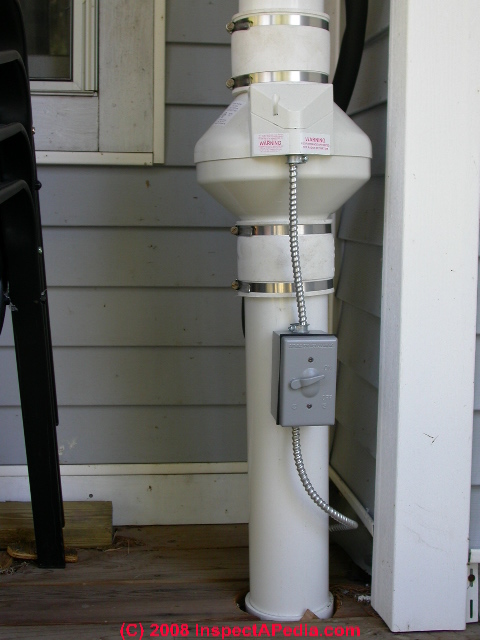 Here is a summary of the health risks and property value risks associated with radon gas.
Here is a summary of the health risks and property value risks associated with radon gas.
For a thorough discussion of radon hazards in buildings, radon exposure risk levels, cancer risks for radon in air or water, radon measurement advice, and how to mitigate a high indoor radon level,
see RADON HAZARD TESTS & MITIGATION
Radon, a radioactive but odorless and colorless gas occurs naturally in the soil in some areas. Radon has been associated with lung cancer among people exposed to high levels such as those working in mines.
This data was extrapolated to suggest a possible lung cancer risk if radon reached high levels in residential buildings, into which it might seep from soils below.
Because the radon level in a building varies widely over time, the US EPA suggested that homes with radon above 4 picocuries per liter (pCi/L) based on a short term (typically 4-day) test should perform additional longer-term study to see what the actual annual average exposure is. Here's where things got sticky.
Some homeowners are employed by companies requiring that they move to a new city from time to time.
Some such employees are offered relocation assistance including the purchase of their present home so as to free-up their investment to purchase a new property. Independent "relocation companies" formed to handle this transaction and to actually carry the older home in their property inventory until it could be sold.
Because the relocation companies didn't want to risk discovering that they were holding a high-radon home that might require a $2000-$2500 (typically) repair, these firms took the position that any home (being offered to the relocation plan service) having a screening-test radon level of 4 pCi/L (or above) must be remediated before they would accept the property.
This position converted the EPA's recommendation for further testing into a requirement that thousands of homes at or close to 4 pCi/L of radon must be remediated. The actual risk to a building occupant from radon at this level is practically nil.
Put it this way: if you breathe radon-contaminated air at 4 pCi/L for 18 hours a day for 70 years, then if you get lung cancer at the end of that period, only then, at that exposure level, could you say that the radon may have caused the lung cancer. Contracting lung cancer before then would be indistinguishable from the general risk level in the population.
Now to be fair, radon risk increases exponentially at higher levels, and is perhaps 80 times greater for people who smoke cigarettes. But in effect, thousands of homes were "remediated" at a level of radon of or close to 4 pCi/L without having demonstrated an actual health risk.
The current level of public enviro-scare about radon is low but not zero, most-likely because of increased familiarity with the issues and because the remediation cost is less than for UFFI and asbestos.
For a thorough discussion of radon hazards in buildings, radon exposure risk levels, cancer risks for radon in air or water, radon measurement advice, and how to mitigate a high indoor radon level, see
- RADON HAZARD TESTS & MITIGATION
- HEALTH EFFECTS OF RADON
- GUIDE TO MEASURING RADON
- EFFECTS OF RADON ON HOME SALES
- HOW TO REMOVE INDOOR RADON
- RADON HAZARD IN UNDERGROUND HOMES
- RADON ENVIRO-SCARE
Enviro-Scare about Urea Formaldehyde Foam Insulation - UFFI and Cancer
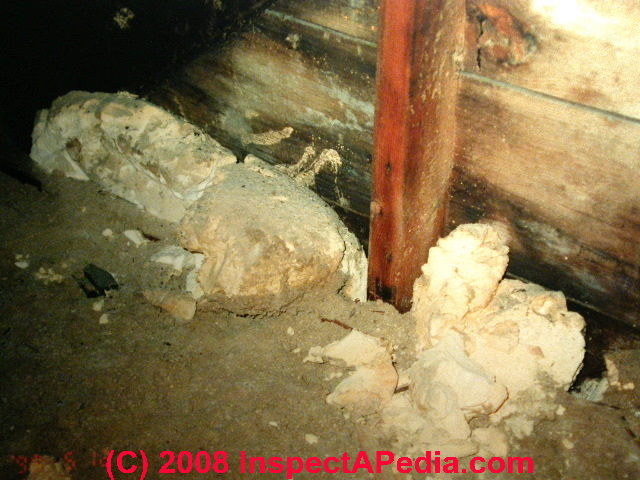 Here is a summary of the actual health risks and property value risks associated with UFFI or urea formaldehyde foam insulation.
Here is a summary of the actual health risks and property value risks associated with UFFI or urea formaldehyde foam insulation.
See UREA FORMALDEHYDE FOAM INSULATION, UFFI for details about UFFI insulation.
This foam insulation was a popular insulation retrofit product used in the 1970's. As an expanding foam insulation it was mixed on-site and pumped into building wall or other cavities in older buildings which were not previously insulated.
Some research suggested that formaldehyde out gassing from the insulation formed a significant cancer risk.
The level of formaldehyde that out gassed from UFFI depended in part on how the foam product was mixed at the site, and not all building insulation projects using this substance produced the same level of formaldehyde.
Eventually, additional study suggested that the initial cancer risk from formaldehyde was not supported, at least in this application.
More interesting to me was the observation that perhaps largely because this insulation formed an open-celled foam, even if there were high initial formaldehyde out gassing levels, after months or at most a few years, even careful measurements were unable to detect any levels of ongoing formaldehyde out gassing from this material.
Only people hypersensitive to chemicals seem to have any remaining reaction to this material, and even in that case a study of such reactions is complicated by the observation that higher levels of formaldehyde out gassing from building products occurs from some furniture padding and from some glues or finishes used in chipboard based cabinets or sub flooring.
Yet at the peak of the UFFI enviro-scare, and exacerbated by inconsistent advice offered by government and private health experts, some buildings were sold at a significant discount to allow for extensive gutting, cleaning, and re-insulating of building cavities.
Inspecting several such projects it was interesting to note that the one real defect of this insulation product was that depending on how it was mixed, it shrank after installation, leaving gaps of no actual insulation at the top and sides of wall cavities - it wasn't the perfect insulating seal that was promised, but it was not the carcinogen that was feared.
The current level of public fear of UFFI is quite low, but because some people
are either hyper sensitive to chemicals in their environment, or because others have a very high level of concern for any
environmental or possible environmental issue, consumer concern for this issue has not fallen to zero.
See UREA FORMALDEHYDE FOAM INSULATION, UFFI for details about UFFI insulation.
Enviro-Scare about Toxic or Allergenic Mold in buildings
We have had more to say on this and on mycophobia than should be repeated here. There are both legitimate and imagined hazards associated with mold and allergens in buildings. For full details about the sources, effects, and costs of fear of mold, both justified and exaggerated.
Public concern with "black mold" is perhaps confusing since some of the most problematic molds in buildings are not dark in color and in fact can be a bit difficult to see (Aspergillus sp. and Penicillium sp. for example.)
More about mold hazards, real and exaggerated
- MOLD: A COMPLETE GUIDE TO MOLD
- MVOCs & MOLDY MUSTY ODORS
- MYCOPHOBIA, STAINS MISTAKEN for MOLD - don't mistake dirt for mold
- MYCOTOXIN EFFECTS of MOLD EXPOSURE
Readers should see The MOLD INFORMATION CENTER: What to Do About Mold in buildings, When and How to Inspect for Mold, Clean Up Mold, or Avoid Mold Problems. The toxic or "black mold" enviro-scare level is currently past the peak of consumer concern but is no less than mid-slope on the declining side of the curve.
Related Research on Fear of Mold - Mycophobia
and how that may result in excessive costs as well as under-appraised risks.
- Frazer, Jennifer Tucker. MOLD FEVER: HOW A BIZARRE LIFE FORM PENETRATED POPULAR CONSCIOUSNESS AND LAUNCHED A CREEPING HYSTERIA [PDF] PhD diss., Massachusetts Institute of Technology, 2004.
Abstract:
Molds are everywhere, lately: in our homes, newspapers, and courtrooms, and on our minds. In the past few years, mold has gone from a blip on the radar of public consciousness to a major force in home inspections, insurance, litigation, and testing. Never before have people been so concerned over a group of creatures that--undeniably--have been there all along.
This thesis--written as a four-part newspaper series--details the mold hysteria phenomenon, the biology of indoor molds, the science of indoor mold and health, and the profit-making frenzy that capitalized on mold fever. - Hope, Janette. "A review of the mechanism of injury and treatment approaches for illness resulting from exposure to water-damaged buildings, mold, and mycotoxins." The Scientific World Journal 2013 (2013).
Abstract:
Physicians are increasingly being asked to diagnose and treat people made ill by exposure to water-damaged environments, mold, and mycotoxins. In addition to avoidance of further exposure to these environments and to items contaminated by these environments, a number of approaches have been used to help persons affected by exposure to restore their health. Illness results from a combination of factors present in water-damaged indoor environments including, mold spores and hyphal fragments, mycotoxins, bacteria, bacterial endotoxins, and cell wall components as well as other factors.
Mechanisms of illness include inflammation, oxidative stress, toxicity, infection, allergy, and irritant effects of exposure. This paper reviews the scientific literature as it relates to commonly used treatments such as glutathione, antioxidants, antifungals, and sequestering agents such as Cholestyramine, charcoal, clay and chlorella, antioxidants, probiotics, and induced sweating. - MOLD PRODUCTS, INEFFECTIVE - mold sniffing dogs?
- OTHER PEOPLE's MONEY - why consultants spend your money to reduce their risk
- Perry, Elizabeth L. "Why Fear the Fungus-Why Toxic Mold Is and Is Not the Next Big Toxic Tort." Buff. L. Rev. 52 (2004): 257.
Excerpt:
Introduction: In homes and buildings across Amerida, a small enemy lurks in dark corners, behind walls, and above ceilings. It rests on damp surfaces and feeds on tile [sic - nonsense@ - Ed.], sheetrock and wood, releasing toxins which have been linked to health problems ranging from allergic reactions to permanent memory loss. Surprisingly this poison does not stem from carbon monoxide, asbestos, radon, lead paint, or any type of environmental pollutant. Rather this natural toxin originates from what scientists have dubiously labeled toxic mold. - Zacharisen, Michael C., and Jordan N. Fink. "Is indoor “mold madness” upon us?." Annals of Allergy, Asthma & Immunology 94 , no. 1 (2005): 12-13.
Enviro-Scare about Fiberglass insulation fragments in building air and cancer
 The enviro-scare curve for this topic appears to be flatter and more drawn-out than the topics listed above. As with
the electromagnetic field EMF cancer risk topic discussed above, there are various parties with conflicting interests,
all sponsoring research on this topic.
The enviro-scare curve for this topic appears to be flatter and more drawn-out than the topics listed above. As with
the electromagnetic field EMF cancer risk topic discussed above, there are various parties with conflicting interests,
all sponsoring research on this topic.
Our own field investigations find that fiberglass particles are quite common in indoor air as well as in indoor dust samples.
[Click to enlarge any image]
Even in buildings where there is no exposed fiberglass insulation it is common to find a few fiberglass fibers in indoor dust samples.
Such instances of low-level, large-fragment fiberglass indoor presence are unlikely to form a measurable health hazard (citations below), especially where the fibers are large fragments.
Watch out: however, in our OPINION, the presence of small and ultra-small fiberglass fragments in the one-micron range and below are often not detected by conventional environmental testing lab pracices.
Unless the forensic particle laboratory is making a point of looking for and counting small fiberglass fragments in indoor air or dust samples, and unless an appropriate slide preparation method is used, only a large-particle count may be provided and the presence and potential effects of ultra-fine fiberglass dust may be underestimated.
Proper lab procedure and use of mountants with an appropriate refractive index to see glass fragments is critical as otherwise such particles may simply be invisible when viewed using conventional slide preparation methods.
Some research argues that fiberglass particles are larger than and less dangerous than asbestos. However many small fiberglass particles may be in indoor air but may be below the threshold of some common measurement methods.
See FIBERGLASS HAZARDS in buildings.
Our field and forensic lab experience sheds further light on the question of the hazard of small-fragment fiberglass insulation particles in buildings. In our experience and thus OPINION we do not normally find high levels of small fiberglass fiber fragments except when something has happened to create them, as such fragments are not a normal composite of fiberglass insulation as produced by the manufacturers. Examples of activities that increase the chance of small fiberglass fragment production include
- Mechanically damaged fiberglass insulation, more likely to be found in an older building where insulation was walked-on, distrubed by rodents, or similar activities
- Fiberglass insulation in HVAC ducts that has been mechanically damaged and shredded by attempts to mechanically clean fiberglass-lined HVAC ducts
Bottom line
In our OPINION (DF) dust testing for indoor fiberglass insulation contamination is probably not justified unless building history, events, and occupant complaints give cause to raise a specific concern that points in this direction.
Fiberglass IAQ (Indoor Air Quality) Hazard References
- FIBERGLASS IN INDOOR AIR, HVAC DUCTS, AND BUILDING INSULATION
- FIBERGLASS PARTICLE IDENTIFICATION IN THE FIBERGLASS TEST LABORATORY
- MOLD IN FIBERGLASS INSULATION OWENS CORNING FLEX DUCT DETERIORATION AND FAILURESae
- WORLD TRADE CENTER DUST PARTICLE IDENTIFICATION
- FIBERGLASS HAZARDSbuilding insulation and HVAC duct work insulation hazards
- Fiberglass carcinogenicity update: "GLASS WOOL FIBERS EXPERT PANEL REPORT, Part B - Recommendation for Listing Status for Glass Wool Fibers and Scientific Justification for the Recommendation", The Report on Carcinogens (RoC) expert panel for glass wool fibers exposures met at the Sheraton Chapel Hill Hotel, Chapel Hill, North Carolina on June 9-10, 2009, to peer review the draft background document on glass wool fibers exposures and make a recommendation for listing status in the 12th Edition of the RoC.
The National Institute of Environmental Health Sciences is one of the National Institutes of Health within the U.S. Department of Health and Human Services. The National Toxicology Program is headquartered on the NIEHS campus in Research Triangle Park, NC.Following a discussion of the body of knowledge, the expert panel reviewed the RoC listing criteria and made its recommendation.
The expert panel recommended by a vote of 8 yes/0 no that glass wool fibers, with the exception of special fibers of concern (characterized physically below), should not be classified either as known to be a human carcinogen or reasonably anticipated to be a human carcinogen.
The expert panel also recommended by a vote of 7 yes/0 no/1 abstention, based on sufficient evidence of carcinogenicity in well-conducted animal inhalation studies, that special-purpose glass fibers with the physical characteristics as follows longer, thinner, less soluble fibers (for one example, > 15 μm length with a kdis of < 100 ng/cm2/h) are reasonably anticipated to be a human carcinogen for the listing status in the RoC.
The major considerations discussed that led the panel to its recommendation include the observations of tumors in multiple species of animals (rats and hamsters). Both inhalation and intraperitoneal routes of exposure produced tumors, although inhalation was considered more relevant for humans.
- FIBERGLASS INSULATION MOLDoccurrence of mold contamination in fiberglass insulation can be impossible to see with the naked eye, but can be significant
Also see the FEAR-O-METER (linked below) - a promotion theory to convert risk of hidden defects & hazards into action thresholds, for a discussion of how an accumulation of inspection evidence leads to a rational decision to perform invasive or desctructive inspection measures.
Vinyl Chloride & PVC Hazards and Enviro-Scare
Please see VINYL CHLORIDE HEALTH INFO
World Trade Center Dust & Environmental Fear
Please see WTC DUST PARTICLE - MICRO PHOTOGRAPHS
...
Continue reading at FEAR-O-METER: Dan's 3 D's SET REPAIR PRIORITIES or select a topic from the closely-related articles below, or see the complete ARTICLE INDEX.
Or see these
Recommended Articles
- BASKETBALL MOLD SYNDROME - BBMS - a dirt smudge on the ceiling isn't dangerous
- FEAR-O-METER: Dan's 3 D's SET REPAIR PRIORITIES - a promotion theory to convert risk of hidden defects & hazards into action thresholds
- HAZARD vs RISK
- OTHER PEOPLE's MONEY - why consultants spend your money to reduce their risk
Suggested citation for this web page
ENVIRO-SCARE - PUBLIC FEAR CYCLES at InspectApedia.com - online encyclopedia of building & environmental inspection, testing, diagnosis, repair, & problem prevention advice.
Or see this
INDEX to RELATED ARTICLES: ARTICLE INDEX to BUILDING ENVIRONMENT
Or use the SEARCH BOX found below to Ask a Question or Search InspectApedia
Ask a Question or Search InspectApedia
Try the search box just below, or if you prefer, post a question or comment in the Comments box below and we will respond promptly.
Search the InspectApedia website
Note: appearance of your Comment below may be delayed: if your comment contains an image, photograph, web link, or text that looks to the software as if it might be a web link, your posting will appear after it has been approved by a moderator. Apologies for the delay.
Only one image can be added per comment but you can post as many comments, and therefore images, as you like.
You will not receive a notification when a response to your question has been posted.
Please bookmark this page to make it easy for you to check back for our response.
IF above you see "Comment Form is loading comments..." then COMMENT BOX - countable.ca / bawkbox.com IS NOT WORKING.
In any case you are welcome to send an email directly to us at InspectApedia.com at editor@inspectApedia.com
We'll reply to you directly. Please help us help you by noting, in your email, the URL of the InspectApedia page where you wanted to comment.
Citations & References
In addition to any citations in the article above, a full list is available on request.
- [1] U.S. Army Field Manual FM-8-285-Noxious_Chemicals discusses Ammonia, Carbon Monoxide, Hydrogen Sulfide, Oxides of Nitrogen, Hazards caused by fire
- [2] Gregory Brown, P.E., Eastern Environmental Engineering Services, Califon NJ, Tel: 908-832-5098, Email: gabrown48@comcast.net. Mr. Brown, a licensed professional engineer in New Jersey and Pennsylvania, provides environmental / compliance, investigation, and remediation services and is the contributor of
ENVIRONMENTAL REGULATIONS, New Jersey - Update on New Jersey Environmental Regulations that impact real estate transactions. - [3] "Arts and Crafts, an Industrial Hygiene Challenge", Monona Rossol, The Synergist, May 2012, pp. 34-37American Industrial Hygiene Association.
- [4] Encyclopedia of Toxicology, 2d Ed., Bruce Anderson (Editor) eta als, Academic Press, ISBN-10: 0127453547, ISBN-13: 978-0127453552 - Quoting:
The second edition of the Encyclopedia of Toxicology continues its comprehensive survey of toxicology. This new edition continues to present entries devoted to key concepts and specific chemicals. There has been an increase in entries devoted to international organizations and well-known toxic-related incidents such as Love Canal and Chernobyl. Along with the traditional scientifically based entries, new articles focus on the societal implications of toxicological knowledge including environmental crimes, chemical and biological warfare in ancient times, and a history of the U.S. environmental movement.
With more than 1150 entries, this second edition has been expanded in length, breadth and depth, and provides an extensive overview of the many facets of toxicology.
Also available online via ScienceDirect - featuring extensive browsing, searching, and internal cross-referencing between articles in the work, plus dynamic linking to journal articles and abstract databases, making navigation flexible and easy. For more information, pricing options and availability visit www.info.sciencedirect.com. - [5] Encyclopedia of Toxicology, Chemicals & Concepts, Philip Wexler (Editor), Academic Press, 1998, ISBN-10: 012227220X,
ISBN-13: 978-0122272202 - Quoting:
The Encyclopedia of Toxicology provides a comprehensive collection of concise and readable explanations of basic principles in toxicology and the potential hazards of chemicals. Written by highly qualified contributors and containing a broad selection of topics, the Encyclopedia of Toxicology is of value to both toxicologists and non-toxicologists, including physicians, attorneys, regulators, safety managers, and environmental engineers-anyone whose work involves the health and safety issues of common and uncommon substances.
The Encyclopedia of Toxicology plays a critical role at the intermediate level by offering more detail than a dictionary while remaining accessible to the generalist in risk assessment, regulation, and consulting. The Encyclopedia includes entries related to research and clinical toxicology, risk assessment, ecotoxicology, epidemiology, radiation, noise, information resources, organizations, and education. With more than 750 entries, extensive cross-references, a detailed index, and numerousreferences to primary and secondary literature, the Encyclopedia will be an indispensable resource. - [6] Encyclopedia of Clinical Toxicology: A Comprehensive Guide to the Toxicology of Prescription and OTC Drugs, Chemicals, Herbals, Plants, Fungi, Marine ...
Clothing and Environmental Toxins, Irving S. Rossoff, Informa Healthcare, 2001, ISBN-10: 1842141015, ISBN-13: 978-1842141014 - Quoting:
An encyclopedic guide to the physical properties and symptomatology, this book describes adverse effects and interactions often not reported by manufacturers and not published in PDRs and the other standard compendia. It is compactly written and easy to read, designed for quick reference and retrieval of vital information about the effects, interactions, and lethal doses of thousands of toxic substances that can destroy health, seriously endanger health, or cause death, and that are in many cases documented nowhere else. An exceptionally complete word index of some 100 pages helps readers locate any topic by reference to substance headings, which are organized A-Z in the text. - [7] Arts, Crafts, & Theater Safety (ACTS), 181 Thompson Street, #23
New York, NY 10012-2586
Telephone: (212) 777-0062
E-Mail: ACTSNYC@cs.com, web search 5/9/12, website: http://www.artscraftstheatersafety.org/ - Quoting:
- [8] The Artist's Complete Health and Safety Guide, Monona Rossol, Allworth Press, 2001, ISBN-10: 1581152043
ISBN-13: 978-1581152043 - Quoting:
Dozens of at-a-glance tables and charts present vital information about art materials, ingredients, technical hazards, proper protective equipment, and safe work practices simply and accurately. This brand-new third edition is now completely revised and expanded to detail lifesaving new safety and ventilation equipment, present urgent new discoveries on toxins and pollutants found in arts and crafts materials, and explain the controversies surrounding new government regulations. A virtual lifesaver for all art and craft workers. - [13] Illustrated theatre production guide, John Holloway, Focal Press, 2002, ISBN 0240804937, 9780240804934
- [15] Cultural Heritage and Aerobiology - [book review] Mandrioli, Caneva, and Sabbioni (English version), in Pan American Aerobiology Association Newsletter.
Cultural Heritage and Aerobiology, Methods and Measurement Techniques for Biodeterioration Monitoring, Paolo Mandrioli, Guilia Caneva, and Cristina Sabbioni, Eds., Kluwer Academic Publishers, 2003 ISBN 1-4020-1622-0 - [16] "Mold/IAQ investigation, The Art School at [privacy deletion]" , Daniel Friedman, 7/22/2005 (private publication). A request for indoor mold contamination investigation at an art school found significant levels of ultra-fine dust traced to a large variety of stored artists materials including glazes & pigments, some of which may be hazardous, including high levels of asbestos, talc, lead, and heavy metals.
- [17] BLOOD in ART WORKS, TESTING FOR, Daniel Friedman,
This article describes and evaluates alternative forensic procedures that were used to test for the presence of blood in a red inscription inside of the lid of an antique wooden memento box that is attributed to the property of and is inscribed and signed "Frida Kahlo". - Consumer Product Safety Commission, 800-638-CPSC.
- US Environmental Protection Agency, Office of Pesticides and Toxic Substances, TSCA Assistance Office (TS-799), 800-424-9065 or 202-554-1404.
- In addition to citations & references found in this article, see the research citations given at the end of the related articles found at our suggested
CONTINUE READING or RECOMMENDED ARTICLES.
- Carson, Dunlop & Associates Ltd., 120 Carlton Street Suite 407, Toronto ON M5A 4K2. Tel: (416) 964-9415 1-800-268-7070 Email: info@carsondunlop.com. Alan Carson is a past president of ASHI, the American Society of Home Inspectors.
Thanks to Alan Carson and Bob Dunlop, for permission for InspectAPedia to use text excerpts from The HOME REFERENCE BOOK - the Encyclopedia of Homes and to use illustrations from The ILLUSTRATED HOME .
Carson Dunlop Associates provides extensive home inspection education and report writing material. In gratitude we provide links to tsome Carson Dunlop Associates products and services.






